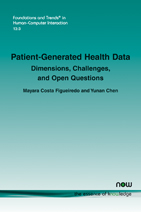Patient-Generated Health Data: Dimensions, Challenges, and Open Questions
By Mayara Costa Figueiredo, University of California, USA, mcostafi@uci.edu | Yunan Chen, University of California, USA, yunanc@ics.uci.edu
Abstract
In this review, we present an overview of patient-generated health data (PGHD) research, focusing on important aspects that inform and define studies in the area. We start by exploring a fundamental question: what is patient-generated health data? We list the main terms and definitions identified from previous research and generate a set of seven key dimensions for understanding PGHD: (1) the health focus of the study, (2) the type of data, (3) who proposes the use of PGHD, (4) whose data are collected, (5) who are the intended users, (6) how PGHD is collected and used, and (7) the duration of PGHD use. We describe these dimensions and discuss their importance to research PGHD. We then present a discussion of the impact of PGHD and related practices in people’s lives and the debates concerning the consequences, both positive and negative, that may arise.
Patient-Generated Health Data: Dimensions, Challenges, and Open Questions
Over the past years, individuals’ and patients’ health data have been increasingly present in public debate. Recently there has been a proliferation of new technologies, particularly sensor and mobile apps, produced to measure and track different aspects of a person’s health and behavior. These data are often termed patient-generated health data (PGHD), a research topic that has been increasingly examined by multiple fields of studies. The use of PGHD is not a new phenomenon; its popularity is associated with the recently increasing interest in patients’ data and the rapid development of technologies that can facilitate data collection and use.
Considering the wide impact and potential benefits of PGHD in healthcare, it is necessary to understand the current landscape and scope of PGHD research, so we can support good practices, work to improve areas that need more attention, promote PGHD benefits, and avoid negative consequences. This review presents an overview of PGHD research, focusing on important aspects that inform and define studies in the area. It starts by exploring a fundamental question “what is patient generated health data?” and lists the main terms and definitions identified from previous research. The authors generate a set of 7 key dimensions for understanding PGHD: 1) the health focus of the study, 2) the type of data, 3) who proposes the use of PGHD, 4) whose data are collected, 5) who are the intended users, 6) how PGHD is collected and used, and 7) the duration of PGHD use. They then present a discussion of the impact of PGHD and related practices in people’s lives and the debates concerning the consequences, both positive and negative, that may arise. They conclude by exploring important open questions in PGHD research.
